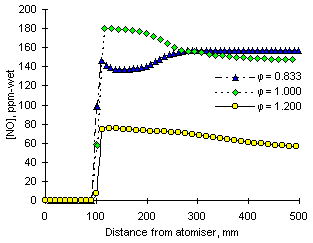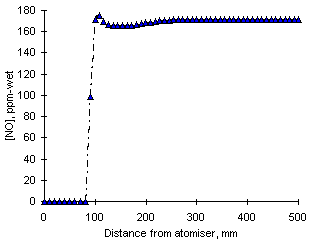
Figure 114: Calculated concentrations of NO from fuel M1 at various equivalence ratios

The formation of NO is almost negligible in the initial stages of the perfectly stirred zone, while the flame temperature is below 400 °C. The concentrations of NO begin to rise as the CSTR zone ends at a distance of 100 mm from the atomiser nozzle, more rapidly in fuel-lean and stoichiometric conditions, due to the presence of amounts of oxygen-containing species.
The rise of NO concentration is arrested when the calculations progress into the PFR (plug flow reactor) zone, where calculations are performed by the modified "CONP" code (the code text can be found in "Appendix IV"). In fuel-lean conditions the concentrations of NO rise again and level off after a short decrease, whereas in stoichiometric and fuel-rich conditions there is a net decrease of the concentration of NO with distance, more pronounced in stoichiometric conditions.
The numerical model yielded final results of the same order of magnitude as the experimental ones in fuel-lean conditions. The largest concentrations of NO at exhaust are obtained at  = 0.833, followed by stoichiometric conditions. The concentrations of NO are lowest at fuel-rich conditions.
= 0.833, followed by stoichiometric conditions. The concentrations of NO are lowest at fuel-rich conditions.
The numerical model is also able to predict the decrease of NO concentrations observed experimentally in the latter part of the drop tube furnace at stoichiometric and fuel-rich equivalence ratios. However, the predictions are merely qualitative as the values of the emissions calculated do not match those obtained experimentally. Despite being most accurate among all results, the values of NO emissions obtained in fuel-lean conditions underestimated the experimental ones by 22 %. At other equivalence ratios the calculated values were much higher than experimental ones. The following Table shows emissions of NO predicted by the model and those obtained experimentally from fuel M1 at 500 mm from the atomiser nozzle:
Equivalence ratio ( ) )
| [NO], ppm-wet Experimental | [NO], ppm Numerical model | Percentage error, % |
|---|---|---|---|
| 0.833 | 206.7 | 156.9 | -24.1 |
| 1.000 | 32.2 | 147.6 | 358.3 |
| 1.200 | 12.6 | 56.1 | 345.2 |
Results from Orimulsion are discussed in the following paragraphs. As in experimental trials only one equivalence ratio (fuel-lean,  = 0.833) was attempted with this fuel.
= 0.833) was attempted with this fuel.

 = 0.833
= 0.833
Many similarities to the patterns from fuel M1 were observed. Formation of NO was negligible until the flame temperature had reached 790 °C, attaining a maximum value (183 ppm-wet) on entering the PFR zone. Subsequently, the effect of the PFR flow regime is to cause a slight decrease of the NO concentrations followed by its stabilisation at exhaust. Eventually, the emissions of NO from Orimulsion at  = 0.833 and 500 mm sampling distance were 176 ppm-wet. The experimental value obtained at similar conditions was 269 ppm-wet. Thus, the calculation error was 34.6 %.
= 0.833 and 500 mm sampling distance were 176 ppm-wet. The experimental value obtained at similar conditions was 269 ppm-wet. Thus, the calculation error was 34.6 %.
 Previous |  Table of Contents |  Next |